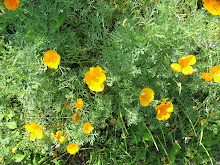A lunch date with relatives kept me from attending the entire day, but my timing seemed right when I entered the plenary room a little after noon and saw my friend and fellow Minton Stable Gardener Joe Bergin sharing new lyrics to the David Mallett's "Garden Song." He then read "The Garden Gate," which he had introduced at the Sounds of the Garden benefit last month. This poem, which he and Terry McAweeney had written in memory of John Carroll, is a celebration of the pleasures of community gardening. BNAN plans to publish it soon on its website.
In her welcome address, BNAN President Valerie Burns (above) reminded those of us with community plots how lucky we are. She recently looked at five of the gardens in the BNAN network, containing a total of 370 plots, and discovered that the combined total on their waiting lists had reached 130 (a member of the MSG Steering Committee revealed to me that there were 30 people on ours). Also, BNAN has had trouble ordering the 12,000 seeds they provide annually to their gardens because the companies have been running out. Apparently the recession we're in has increased people's interest in growing their own food. She highlighted the findings from their study of the economic advantages of gardening. She encouraged those of us who have maintained more than one community plot or enjoy access to plentiful space on our own property in addition our plots to consider sharing our space. She also invited wait-listed people to contact BNAN if they were interested in an available plot in one of seven other community gardens that still had them.
Like every year, I regretted not being able to attend all of the workshops available, which this year included "Weed or Wildflower--Kill It or Eat It?" and "Safer Urban Soil." But I did catch a few short movies and the final plenary session, during which the news was released that Boston Urban Gardeners, an organization that was behind the first Gardeners Gathering 34 years ago and had to close its doors recently due to economic difficulties, would be transferring its ownership to BNAN; therefore, its gardens, including the one next to its home base at 57 Lamartine Street in Jamaica Plain would benefit from the same support and resources that we at the MSG receive.
Before the Community Gardening Awards and final raffle, Boston Mayor Thomas Menino made his annual speech to the standing-room-only crowd. He emphasized his two main points more than once: 1) Come harvest time in August, don't forget to invite him to our gardens and 2) The city will continue to provide free compost to the community gardens. Given all of the other cutbacks, that can be regarded as good news. The award recipients were the two Charles River gardens, which were inducted into the Hall of Fame, a lifetime achievement award for Arthur Kane, and for the Rookie Garden, the Harrison Urban Garden (HUG), started on the roof of a parking garage at 700 Harrison Avenue in Boston.
If you are a Minton Stable Gardener, I'll see you tonight at the meeting.









